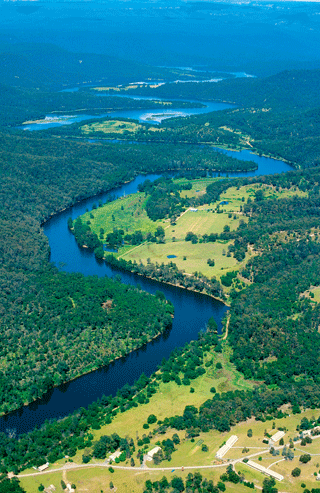
|
Published:
Linking land clearing to drought and climate change
A recent Australian study suggests that land clearing over the past 200 years may have been as significant a factor in this country’s droughts and changing climate as increasing carbon dioxide in the atmosphere.

|
|
The intensity and duration of droughts may have increased in south-eastern Australia as a result of large-scale clearance of native vegetation. Credit:
ScienceImage
|
University of Queensland researchers have produced evidence for the possible link between land clearing and climate change in south-eastern Australia. The work is part of a broader climate modelling project – involving Land & Water Australia and the Queensland Climate Change Centre of Excellence – being managed by Dr Clive McAlpine.
Dr McAlpine’s team have used the CSIRO MARK 3 climate model – the same one used by the Intergovernmental Panel on Climate Change (IPCC) – to simulate the climate impacts of land clearing over the past 200 years.
To find out how changes in vegetation cover have affected climate, the carbon dioxide levels in the simulation were kept constant throughout.
‘We were only looking at the effect of vegetation clearing and nothing else,’ Dr McAlpine explained. ‘Any increases in temperature had to come down to a loss of vegetation.’
The modelling results showed a strong correlation between climate and loss of vegetation from pre-European settlement levels, with an average summer temperature increase in eastern Australia of 0.4–2.0°C, and a 4–12 per cent decrease in summer rainfall.
The results also showed that the intensity and duration of droughts may have increased in south-eastern Australia as a result of large-scale clearance of native vegetation, amplifying the effects of El Niño-related droughts, and increasing the annual number of days with 35-plus degree temperatures.
‘I think there are some warning signs there for the future of Australia. As the climate gets drier and hotter, which it is, the landscape’s going to get drier, and the vegetation is going to become more stressed,’ Dr McAlpine said.
‘It seems to be the region from southern Queensland down into regional Victoria – the Murray-Darling Basin – which is most affected.
‘We’re concerned we may be heading into a very difficult and irreversible situation in terms of climate change and landscapes.’
‘Biotic pump’ causing inland rain?
How could the presence or absence of trees affect rainfall? Russian researchers, Dr Anastasia Makarieva and Dr Victor Gorshkov of the St Petersburg Nuclear Physics Institute, have published a paper in the journal Ecological Complexity suggesting how coastal deforestation and land clearing could lead to desertification inland.
They theorise that coastal forests generate winds that push water thousands of kilometres inland – a ‘biotic pump’.
To argue their theory, the two scientists compared the climate of northern Australia – where annual rainfall drops from 1600 mm in vegetated coastal areas to 200 mm in the arid inland 1500 kilometres away – with the Congo, which has forest cover from coast to interior, and where rainfall levels inland are as high as at the coast.
Makarieva and Gorshkov’s biotic pump theory has been supported by British forest scientist Doug Shiel, of the Institute of Tropical Forest Conservation in Kabale, Uganda. Reviewing the Russian research in the journal Bioscience, Dr Shiel highlighted the finding that ‘even localised clearing might ultimately switch entire continental climates from wet to arid, with rainfall declining by 95 per cent’.

|
|
Box timber country, found from the Queensland to Victorian borders, has been extensively cleared since European settlement. Credit:
ScienceImage/Willem van Aken
|
Indeed, the Russian scientists argued that the burning of coastal forests by early Australians may have shut down this continent’s biotic pump, shifting the prevailing climate from humid to arid.
Changing the air–land heat balance
While the biotic pump may explain rainfall variations, a different mechanism may be at work when it comes to temperature increase due to loss of vegetation. Dr McAlpine believes the temperature increase is due to a change in the energy balance between the land surface and the atmosphere.
‘There are two energies involved [in atmospheric temperature rise],’ he said. ‘First, there’s the latent heat, that is, the evapotranspiration from the trees, which is decreasing.’ Evapotranspiration is the total water vapour released from trees into the atmosphere – the sum of surface water evaporation and water from plant transpiration. Once in the atmosphere, this water vapour has a cooling effect.
The second energy involved in atmospheric temperature rise, said Dr McAlpine, is ‘sensible heat’ – heat radiated back into the atmosphere from the land surface, which we know to be increasing, making the atmosphere hotter and drier.
‘Trees act like a water pump,’ he said. ‘They take water from the subsoil and they evapotranspirate over a long period of time, cooling the surface, but also putting moisture into the atmosphere. Whereas, if you’ve got cropping, especially bare paddocks, the ground surface is a lot hotter and moisture is evaporated a lot quicker through either the crops or the bare soil.’
Climate change problem not just emissions
Dr McAlpine believes that, at least within Australia, land clearing could be of the same level of importance as greenhouse gas emissions when it comes to climate change.
‘What we’re saying is that climate change is a multi-dimensional process and we need to look at more than just reducing greenhouse gas emissions – we also need to look at how we’re managing our land surface in the future,’ he said.
‘I’m not saying we shouldn’t be reducing carbon dioxide emissions – we have to reduce them – but there’s a lot of dangerous signals that we’re heading into pretty serious climate change, so we need to look at other ways besides just reducing carbon dioxide levels.
‘I think it’s a question of scale. Certainly on a global scale, carbon dioxide is the big thing, but when you come down to a regional scale, land clearing can be just as important.’

|
|
Researchers have been modelling what would happen if trees were extensively reintroduced to south-east Australia’s landscape. Credit:
ScienceImage/Gregory Heath
|
Reintroducing vegetation to the landscape would not only help restore the energy balance but would also help to sequester carbon from the atmosphere, added Dr McAlpine.
In fact, the University of Queensland research team now plans to investigate what would happen to the climate if vegetation were returned to the landscape under different levels of atmospheric carbon dioxide.

|
|
Russian scientists believe forests in central Africa generate winds that push water thousands of kilometres inland – a ‘biotic pump’. Credit:
iStockphoto/Guenter Guni
|
The research also has implications for bushfire-prone areas in Victoria, where there have been calls to clear large areas of bushland after this year’s Black Saturday bushfires.
‘The “bulldozer solution” of clearing large tracts of bush to reduce the risk of bushfires will only compound the problem – by clearing the land, you get a hotter land surface, so bushfires will be more severe,’ said Dr McAlpine.
‘Rather, we need to restore and actively manage native forests and woodlands for the multiple ecosystem services they can provide.’
More information:
McAlpine CA et al. (2007) Modelling the impact of historical land cover change on Australia’s regional climate. Geophysical Research Letters 34, http://dx.doi.org/10.1029/2007GL031524.
Makarieva AM, Gorshkov VG and Bai-Lian L (2009) Precipitation on land versus distance from the ocean: evidence for a forest pump of atmospheric moisture. Ecological Complexity, doi:10.1016/j.ecocom.2008.11.004.
Shiel D and Murdiyarso D (2009) How forests attract rain: an examination of a
new hypothesis. BioScience 59(4), 341–7, www.biosciencemag.org.



